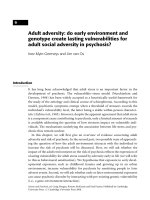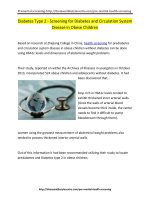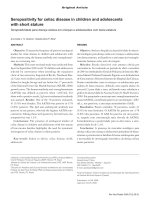Early (nhỏ hơn 8 days) postnatal corticosteroids for preventingchronic lung disease in preterm infants (review)
Bạn đang xem bản rút gọn của tài liệu. Xem và tải ngay bản đầy đủ của tài liệu tại đây (985.2 KB, 27 trang )
Early (< 8 days) postnatal
corticosteroids for preventing
chronic lung disease in preterm
infants (Review)
L/O/G
Bs.Trình Thị Thu Hà
Khoa HSSS
Overview
Chronic lung disease: a major
problem in neonatal intensive care units
Persistent inflammation in the lungs
is the most likely underlying
pathogenesis
Corticosteroids: used to either
prevent or treat chronic lung disease
because of their potent antiinflammatory
effects but there are major adverse
effects of the drugs
Early (< 8 days) postnatal
corticosteroids for preventing chronic
lung disease in preterm infants?
Objectives
To examine the relative benefits and
adverse effects of postnatal corticosteroids
commenced within the first seven days of
life to preterm infants at risk of developing
chronic lung disease
Results:
• 29 RCTs
• 3750 participants: Preterm infants at
risk of developing chronic lung disease,
including those who are ventilatordependent
• Types of interventions: Intravenous or
oral corticosteroids versus control
(placebo or no treatment).
Data collection and analysis
1.
2.
3.
4.
5.
Mortality,
Chronic lung disease,
Death or chronic lung disease,
Failure to extubate,
Complications during the primary
hospitalisation,
6. Long-term health outcomes.
1. Mortality:
no evidence that early postnatal
corticosteroid treatment reduced mortality
either at 28 days, discharge, latest age
possible to determine the outcome
2. Chronic lung disease:
reduce: the incidence of chronic lung disease
at 28 day or 36 weeks, later corticosteroid
treatment overal
3. Death or chronic lung disease
reduce the incidence of death or chronic
lung disease
4. Failure to extubate:
reduced the rates of failure to extubate at
3 days
4. Failure to extubate:
reduced the rates of failure to extubate at
7 days
4. Failure to extubate:
reduced the rates of failure to extubate at
14 days
4. Failure to extubate:
reduced the rates of failure to extubate at
28 days
5. Complications during the primary
hospitalisation
• Early corticosteroids reduced the risk of:
1. Patent ductus arteriosus (typical RR 0.79,
95% CI 0.72 to 0.85; typical RD -0.09, 95% CI 0.12 to -0.06; 23 studies and 3492 infants).
2. Any retinopathy of prematurity (typical RR
0.88, 95% CI 0.80 to 0.97; 10 studies and 1345
infants)
3. Severe retinopathy of prematurity (typical RR
0.79, 95% CI 0.65 to 0.97; RD -0.04, 95% CI 0.07 to -0.01; 13 studies and 2056 infants)
5. Complications during the primary
hospitalisation
• There were no significant effects on:
1.Infection (typical RR 1.02, 95% CI 0.93 to
1.13; 23 studies and 3558 infants)
2. Pulmonary air leaks (typical RR 0.93,
95% CI 0.75 to 1.15; 14 studies and 2604
infants)
3. Severe intraventricular haemorrhage
(typical RR 0.95, 95% CI 0.82 to 1.10; 25
studies and 3582 infants)
5. Complications during the primary
hospitalisation
4. Periventricular leukomalacia (typical RR
1.18, 95% CI 0.84 to 1.65; 13 studies and
2186 infants)
5. Pulmonary haemorrhage (typical RR 1.16,
95% CI 0.85 to 1.59; nine studies and 1299
infants)
6. Necrotising enterocolitis (RR 0.87, 95%Cl
0.87 to 1.08)
5. Complications during the primary
hospitalisation
Adverse effects:
7. Hyperglycaemia RR 1.33,95%Cl [1.20, 1.47]
8. Hypertention RR 1.85,95%Cl [1.54,2.22]
9. Hypertrophic cardiomyopathy RR 4.33,95%Cl
[1,40, 13.37]
10. Growth failure RR 6.67,95%Cl[ 2.27. 19.62]
11. Gastrointestinal bleeding RR 1.86,95%Cl
[1.35, 2.55]
12. Gastrointestinal perforation RR 1.81,95%Cl
[1.233, 3.48]
6. Long-term health outcomes
• 12 trials:
• There were non-significant effects on
major neurosensory disability
• Developmental delay: increased with
corticosteroids in one study with the
criteria for the diagnosis not explicit
• Cerebral palsy: increased with
corticosteroids
• Moreover the rates of the combined
outcomes of death or cerebral palsy, or of
death or major neurosensory disability: not
significantly increased
• There were no significant effects on other
long-term outcomes of blindness,
deafness, formal psychometric testing,
abnormal electroencephalogram (EEG),
behaviour problems or rehospitalisation in
infancy
Subgroup analysis by type of corticosteroid used:
Dexamethasone:used in most studies (n = 20);
only 9 studies used hydrocortisone the
beneficial and harmful effects were attributable
to dexamethasone
Hydrocortisone: little effect on any outcomes
except for an increase in intestinal perforation
and a borderline reduction in patent ductus
arteriosus
CONCLUSIONS:
There were significant benefits:
Lower rates of failure to extubate
Decreased risks of chronic lung disease at
both 28 days and 36 weeks’ postmenstrual
Death or chronic lung disease at 28 days
and 36 weeks’ postmenstrual age
Patent ductus arteriosus
ROP, including severe ROP.
CONCLUSIONS:
There were no significant differences in:
Mortality,
Infection,
Severe intraventricular haemorrhage,
Periventricular leukomalacia,
Necrotising enterocolitis,
Pulmonary haemorrhage.
Adverse effects:
Hyperglycaemia,
Hypertension,
Hypertrophic cardiomyopathy,
Growth failure,
Gastrointestinal bleeding,
Intestinal perforation,
• Long-term follow-up studies report an increased
risk of abnormal neurological examination and
cerebral palsy. However, the methodological
quality of the studies determining long-term
outcomes is limited in some cases
• No study has been sufficiently powered to
detect important adverse long-term
neurosensory outcomes
• Hydrocortisone: has few beneficial or harmful
effects cannot be recommended for the
prevention of chronic lung disease









